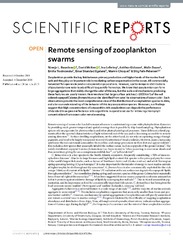Remote sensing of zooplankton swarms
Permanent link
https://hdl.handle.net/10037/14540Date
2019-01-24Type
Journal articleTidsskriftartikkel
Peer reviewed
Author
Basedow, Sünnje Linnéa; McKee, David; Lefering, Ina; Gislason, Astthor; Daase, Malin; Trudnowska, Emilia; Egeland, Einar Skarstad; Choquet, Marvin; Falk-Petersen, StigAbstract
Zooplankton provide the key link between primary production and higher levels of the marine food web and they play an important role in mediating carbon sequestration in the ocean. All commercially harvested fish species depend on zooplankton populations. However, spatio-temporal distributions of zooplankton are notoriously difficult to quantify from ships. We know that zooplankton can form large aggregations that visibly change the color of the sea, but the scale and mechanisms producing these features are poorly known. Here we show that large surface patches (>1000 km2) of the red colored copepod Calanus finmarchicus can be identified from satellite observations of ocean color. Such observations provide the most comprehensive view of the distribution of a zooplankton species to date, and alter our understanding of the behavior of this key zooplankton species. Moreover, our findings suggest that high concentrations of astaxanthin-rich zooplankton can degrade the performance of standard blue-green reflectance ratio algorithms in operational use for retrieving chlorophyll concentrations from ocean color remote sensing.
Description
Accepted manuscript version, licensed CC BY-NC-ND 4.0. Source at https://doi.org/10.1038/s41598-018-37129-x.


 English
English norsk
norsk